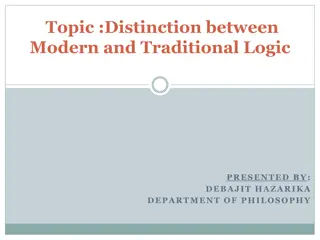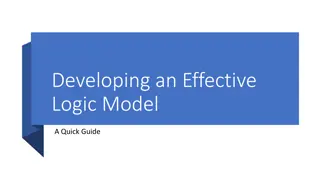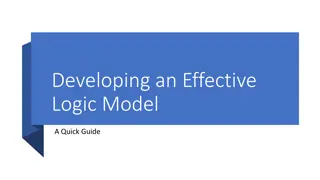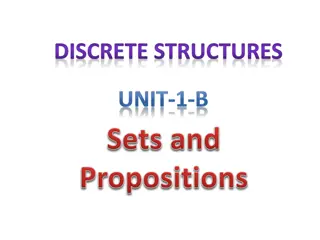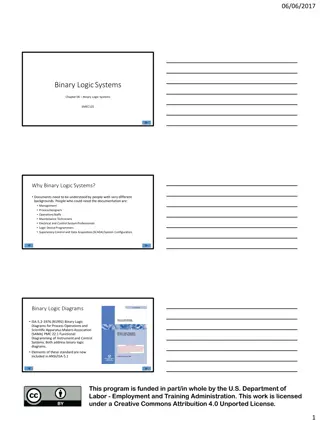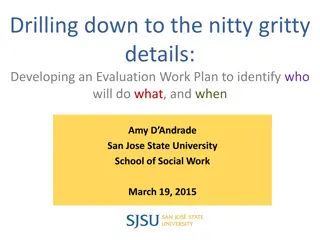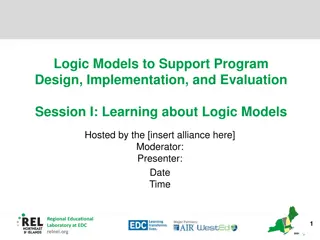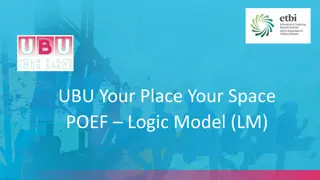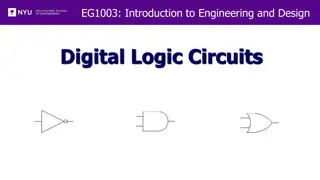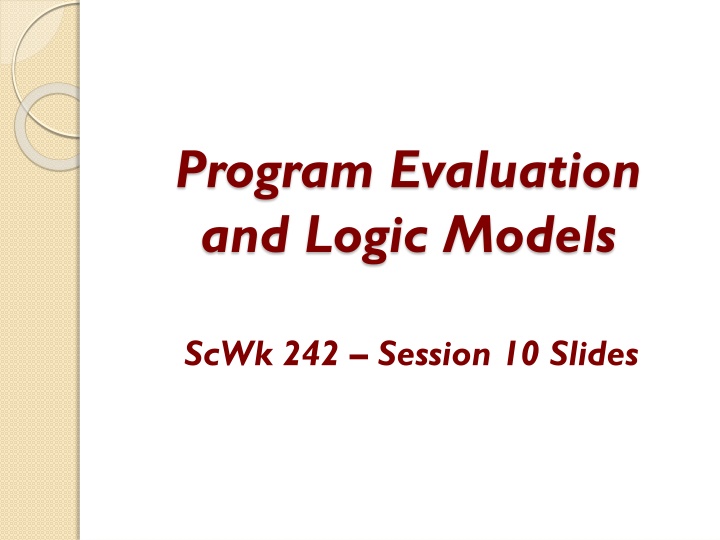
Program Evaluation and Logic Models in Social Work
Explore the purpose and methods of program evaluation, distinguish it from group research designs, and delve into logic models to assess program effectiveness and outcomes in social work practice. Discover the significance of community/local and intervention-specific logic models in addressing social issues.
Download Presentation

Please find below an Image/Link to download the presentation.
The content on the website is provided AS IS for your information and personal use only. It may not be sold, licensed, or shared on other websites without obtaining consent from the author. If you encounter any issues during the download, it is possible that the publisher has removed the file from their server.
You are allowed to download the files provided on this website for personal or commercial use, subject to the condition that they are used lawfully. All files are the property of their respective owners.
The content on the website is provided AS IS for your information and personal use only. It may not be sold, licensed, or shared on other websites without obtaining consent from the author.
E N D
Presentation Transcript
Program Evaluation and Logic Models ScWk 242 Session 10 Slides
Review Program Evaluation Seeks to answer the overall question of whether a program (or policy, initiative, project, etc ) is effective or not. How is program evaluation different from group research designs, which also seek to determine program effectiveness? Generally larger in scope and goes beyond testing two groups for statistically significant differences on a few outcome measures Uses a variety of research methods to assess a variety of questions 2
Program Evaluation Tasks Program evaluation also can include research activities focused on: collecting information about the needs of a community to inform program development (formative evaluations), documenting the types of services delivered, how they are delivered, and the number and type of participants (process) As well as short-term, intermediate, and long-term outcomes. Used in both government and not for-profit organizations. In for-profit organizations it is easy to determine effectiveness since the goal is money, in other programs it may be more difficult to determine what the program should be achieving. In order to determine program effectiveness, program evaluation strategies usually involve the creation of a logic model. 3
Logic Models and Evaluation Logic models typically provide a comprehensive description of three core aspects of a program (or policy, initiative, project, etc .): Inputs: Concrete things that are invested in the program these are the core aspects of a program that allow the program to actually be implemented (e.g. funding, staff, office space, etc ). Outputs: Include the activities (e.g. actual services) that are delivered by the program (e.g. counseling, education, training, etc ), and participation in these services by clients. Outcomes: Includes short-term outcomes (e.g. acquisition of knowledge) intermediate outcomes (e.g. changes in behavior), and long-term outcomes (e.g. larger-scale outcomes related to the ultimate impact on the program). 4
Types of Logic Models Community/Local Logic Model Depicts a community s theory of change to address a particular problem of focus, the behavior(s) contributing to the problem, the local factors thought to contribute to the behaviors. These local contributing factors present opportunities for intervention using evidence based strategies (programs, policies, practices) Intervention-Specific Logic Model Depicts how a set of activities associated with a given intervention (program, policy or practice) are related to the outcomes that result from implementing the intervention 5
Sample: Community Logic Model For Preventing Alcohol-Involved Traffic Crashes - Substance- Related Consequences Substance Use Intervening Variables Strategies (Examples) Easy RETAIL ACCESS to Alcohol for youth Retailer Education Underage BINGE DRINKING Enforce underage retail sales laws Low ENFORCEMENT of alcohol laws Social Event Monitoring and Enforcement Underage Alcohol-involved traffic crashes Among 15 to 24 year olds Easy SOCIAL ACCESS to Alcohol DRINKING AND DRIVING - Low PERCEIVED RISK of alcohol use Youth Education Young Adult BINGE DRINKING Media Advocacy to Increase Community Concern about Underage Drinking SOCIAL NORMS accepting and/or encouraging youth drinking Young Adult Restrictions on alcohol advertising in youth markets interventions DRINKING AND DRIVING PROMOTION of alcohol use (advertising, movies, music, etc) music, etc) Low P 6
Prevention Interventions Interventions may combine various strategies Participant based programs, typically guided by curriculum or manual Policies that affect how, where and under what conditions substances are sold, purchased, possessed, and used Practices include rules and standards for implementing policies as well as non- participant based universal approaches for communicating prevention messages to target populations 7
Interventions Logic Models What outcome(s) is the program aiming to achieve among which population(s)? Why? What theories is the program based on? What activities are implemented to accomplish this outcome? What are the immediate effects of these activities? What underlying factors (e.g. risk and protective factors) does this outcome contribute to over time? What long term changes or impacts does the program contribute to? 8
Logic Model Elements Inputs - what is invested by the implementing organization(s) Outputs - program activities, who and how many reached Outcomes immediate results of program activities Impacts cumulative changes to community conditions (e.g. changes in risk/protective factors, substance use and consequences) 9
Intervention-Specific Logic Model 10 Theoretical Framework on which intervention is based INPUTS OUTPUTS OUTCOMES Long-term Activities Participation Short Medium Program investments What we invest What we do Who we reach under what conditions What results 10
Theoretical Framework Explains established the theory that the intervention is based on Theory should be empirically tested and empirically supported in multiple research studies Logic model details how the proposed intervention applies and incorporates established theory 11
Organizational Inputs Consider: What we Invest: Staff What investments does the strategy require? What organizations make/will make these investments? Expertise (including needed training) Partners and volunteers Time Money Technology/equipm ent Space Materials 12
Organizational Outputs Who we reach What we do Actions taken to accomplish outcomes Training Education Presentations Facilitate Work with media Characteristics of target population Geography Age Universal, selective, indicated Other characteristics 13
Outcomes and Impacts Intermediate Outcomes and Impacts that occur over time Short Term Outcomes resulting from outputs Decision making Awareness Knowledge Opinions Attitudes Aspirations Skills Action, Behavior, Practice Policies Social Action Consequences (health, social, economic, etc.) 14
Example: Intervention-Specific Logic Model INPUTS OUTPUTS OUTCOMES/IMPACTS Parents identify appropriate actions to take Develop parent ed curriculum Parents increase knowledge of child dev Reduced youth alcohol use Staff Deliver series of interactive sessions focused on child development, parenting styles, and parenting practices Money Parents use effective parenting practices Parents better understand their own parenting style Reduced consequenc es Targeted parents attend Training Partners Improved child- parent relations Parents gain skills in effective parenting practices including family management Research Space Facilitate support groups where parents problem-solve Materials Reduced social access to alcohol 15
Benefits of Establishing Evidence Helps to maximize evaluation resources by identifying key outcomes for evaluation Helps to identify evaluation questions of interest Helps to identify evaluation methods, instruments and measures Helps to plan for timing of evaluation data collection 16
Logic Model & Evaluation Questions Needs assessment: What are the characteristics, needs, priorities of target population? What are potential barriers/facilitators? Process evaluation: How is program implemented? Are activities delivered as intended? Are participants being reached as intended? What are participant reactions? Outcome evaluation: To what extent are desired changes occurring? For whom? Is the program making a difference? What seems to work? Not work? What are unintended outcomes? 17
EVALUATION: What do you (and others) want to know about this program? Parents increase knowledge of child dev Develop parent ed curriculum Parents identify appropriate actions to take Staff Improved child- parent relations Deliver series of interactive sessions Money Parents better understand their own parenting style Targeted parents attend Partners Parents use effective parenting practices Research Parents gain skills in effective parenting practices Increased Family Bonding Facilitate support groups Potential Evaluation Questions To what extent did behaviors change? For whom? Why? What else happened? To what extent are relations improved? Does this result in stronger families? What amount of $ and time were invested? What did partners do? How many sessions were actually delivered? Lessons delivered as designed? # Support groups delivered Who/how many attended/did not attend? Did they attend all sessions? Were they satisfied? Will they come again? To what extent did knowledge and skills increase? For whom? Why? What else happened? 18
Developing an evaluation plan for your logic model 1. Goal/Theory: 19 2. Evaluation Questions 3. Indicators 4. Timing 5. Data collection Data Sources Methods Sample Instruments Inputs Outputs Outcome s 19
Logic Models - Summary Demonstrates accountability with focus on outcomes Links activities to results: Prevents mismatches Integrates planning, implementation, evaluation and reporting Creates understanding Promotes learning A way of thinking not just a pretty picture 20


